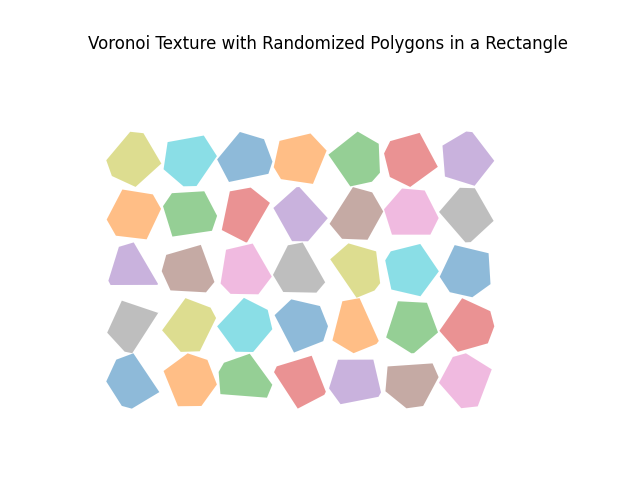Devlog 3- Voronoi textures using roots of unity
Hi all, Happy Valentines Day guys! ❤️ to all the hearbreaks…I hope they heal someday.
So, today our goal is to generate a weird looking but some what acceptable voronoi texture. Let’s scale the phas eoffset polygons in a rectangle.
Tiling the phase offset polygons
We don’t care about the gaps between polygons as some family vooronoi textures can have gaps, so we dont’ have to do perfect tilign Yet!
Take this python code:
import numpy as np
import matplotlib.pyplot as plt
from scipy.spatial import Voronoi, voronoi_plot_2d
def generate_randomized_polygon(n, offset_range=0.1, randomize=True, scale=1.0):
"""
Generates a polygon based on the n-th roots of unity with optional random offsets.
Scales the resulting polygon.
Parameters:
n (int): Number of sides of the polygon.
offset_range (float): Maximum offset for randomizing the angle (radians).
randomize (bool): If True, randomize angles; otherwise, keep a perfect polygon.
scale (float): Scaling factor for the polygon.
Returns:
np.ndarray: x and y coordinates of the vertices.
"""
angles = np.linspace(0, 2 * np.pi, n, endpoint=False)
if randomize:
random_offsets = np.random.uniform(-offset_range, offset_range, n)
angles += random_offsets
points = np.exp(1j * angles) * scale
return points.real, points.imag
def create_voronoi_texture_in_rectangle(rows, cols, n_sides, offset_range, scale=1.0):
"""
Creates a Voronoi texture with randomized polygons inside a large rectangular bounding box.
Parameters:
rows (int): Number of rows in the grid.
cols (int): Number of columns in the grid.
n_sides (int): Number of sides for the polygons.
offset_range (float): Randomization range for polygon vertices.
scale (float): Scale of the polygons.
Returns:
None
"""
centers = []
all_vertices = []
# Generate polygons and collect their centers
for row in range(rows):
for col in range(cols):
x_offset, y_offset = col * 1.2, row * 1.2
x, y = generate_randomized_polygon(n_sides, offset_range, scale=scale)
x += x_offset
y += y_offset
all_vertices.append((x, y))
centers.append((x_offset, y_offset))
# Convert centers to an array for Voronoi computation
centers = np.array(centers)
# Generate Voronoi diagram
vor = Voronoi(centers)
# Overlay polygons
for vertices in all_vertices:
x, y = vertices
plt.fill(x, y, alpha=0.5)
# Set rectangle bounds
plt.xlim(-1, cols * 1.2 + 1)
plt.ylim(-1, rows * 1.2 + 1)
# Remove gridlines and axes
plt.gca().set_aspect('equal', adjustable='box')
plt.axis('off') # Completely remove axes and gridlines
plt.title("Voronoi Texture with Randomized Polygons in a Rectangle")
plt.show()
# Parameters
rows, cols = 5, 7 # Grid size
n_sides = 6 # Number of sides for each polygon
offset_range = 0.6 # Randomization range
scale = 0.6 # Scale for polygons
create_voronoi_texture_in_rectangle(rows, cols, n_sides, offset_range, scale)
This will generate the output as below:
We have a very weird looking voronoi texture generated using roots of unity equation, next I’ll try to parametrize it more and pack it tightly to make it look like a real world voronoi texture.

Noice we are getting forward, this post is just to show some progress. Let’s see what happens in the next devlog.
See you soon.